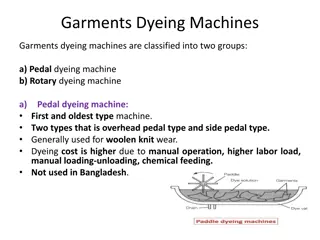Understanding Theory of Machines: Basics and Applications
Theory of Machines deals with the study of relative motion between machine parts and the forces acting on them. This branch of engineering science includes sub-divisions like Kinematics, Kinetics, Dynamics, and Statics. It involves concepts such as links, mechanisms, structures, kinematic pairs, and kinematic chains. A crucial subject for engineers, Theory of Machines helps in designing and analyzing the motion and forces within various mechanical systems.
Download Presentation

Please find below an Image/Link to download the presentation.
The content on the website is provided AS IS for your information and personal use only. It may not be sold, licensed, or shared on other websites without obtaining consent from the author. Download presentation by click this link. If you encounter any issues during the download, it is possible that the publisher has removed the file from their server.
E N D
Presentation Transcript
Theory of Machines Theory of Machines Introduction Theory of Machines: may be defined as that branch of engineering science, which deals with the study of relative motion between the various parts of machine, and forces which act on them. The knowledge of this subject is very essential for an engineer in designing the various parts of a machine. Or defined as: the study of the relative motion between the parts of machine and the study of forces which act on those parts.
Sub- divisions of theory of Machines: They Theory of Machines may be sub- divided into the following four branches: 1- Kinematics: is that branch of theory of machines which is responsible to study the motion of bodies without reference to the forces which are cause this motion, i.e it s relate the motion variables (displacement, velocity, acceleration) with the time. 2- Kinetics: is that branch of theory of machines which is responsible to relate the action of forces on bodies to their resulting motion. 3- Dynamics: is that branch of theory of machines which deals with the forces and their effects, while acting upon the machine parts in motion. Statics: is that branch of theory of machines which deals with the forces and their effects, while the machine parts are rest.
Definitions Links: are rigid bodies each having hinged holes or slot to be connected together by some means to constitute a mechanism which able to transmit motion or forces to some another locations. Types of Links In order to transmit motion, the driver and the follower may be connected by the following three types of links: 1. Rigid link. A rigid link is one which does not undergo any deformation while transmitting motion. Strictly speaking, rigid links do not exist. However, as the deformation of a connecting rod, crank etc. of a reciprocating steam engine is not appreciable; they can be considered as rigid links. 2. Flexible link. A flexible link is one which is partly deformed in a manner not to affect the transmission of motion. For example, belts, ropes, chains and wires are flexible links and transmit tensile forces only.
. Fluid link. A fluid link is one which is formed by having a fluid in a receptacle and the motion is transmitted through the fluid by pressure or compression only, as in the case of hydraulic presses, jacks and brakes. Mechanism: is a combination of rigid bodies which are formed and connected together by some means, so that they are moved to perform some functions, such as the crank- connecting rod mechanism of the I.C. engines, steering mechanisms of automobiles . etc. Structure: is an assemblage of resistant bodies which are not kinematic links because there is no relative motion between the links. There is only straining action due to forces acting on them, for example roof truss. Machine frames etc., are the examples of a structure. Kinematic Pair: The two links or elements of a machine, when in contact with each other, are said to form a pair. If the relative motion between them is completely or successfully constrained (i.e. in a definite direction), the pair is known as kinematic pair. Kinematic Chain: When the kinematic pairs are coupled in such a way that the last link is joined to the first link to transmit definite motion (i.e. completely or successfully constrained motion), it is called a kinematic chain. In other words, a kinematic chain may be defined as a combination of kinematic pairs, joined in such a way that each link forms a part of two pairs and the relative motion between the links or elements is completely or successfully constrained. For example, the crankshaft of an engine forms a kinematic pair with the bearings which are fixed in a pair, the connecting rod with the crank forms a second kinematic pair, the piston with the connecting rod forms a third pair and the piston with the cylinder forms a fourth pair. The total combination of these links is a kinematic chain.
Note: A mechanism with four links it is called a Simple Mechanism. A mechanism with more than four links it is called a Compound Mechanism.
The connection of mechanism parts The mechanism is a combination of rigid bodies which are connected together using different methods: Hinged part: The hinge connection may be used to connect the links together or connect a link to a fixed point, piston, disc .. etc, the connection is achieved using pin, which is pass through the hinge holes
Sliding Parts: The sliding connection may be used to connect two links rotate about fixed points by means of slot, pin and hinge.
Rolling without slipping parts: Rolling without slipping parts:
Translated bodies: There are some bodies in the mechanism which are constrained to move in translation manner, such as the piston of crank- connecting rod mechanism, the body is used to be in translation motion, if any line remains in some configuration during motion; then all the points have the same absolute velocity and acceleration. Velocity diagram: The motion is absolute, then select any fixed point such as o be as a reference point (i.e point of zero velocity). Draw the path of translation. If vBis known, select a scale factor to draw the velocity diagram (denoted by SFv)























